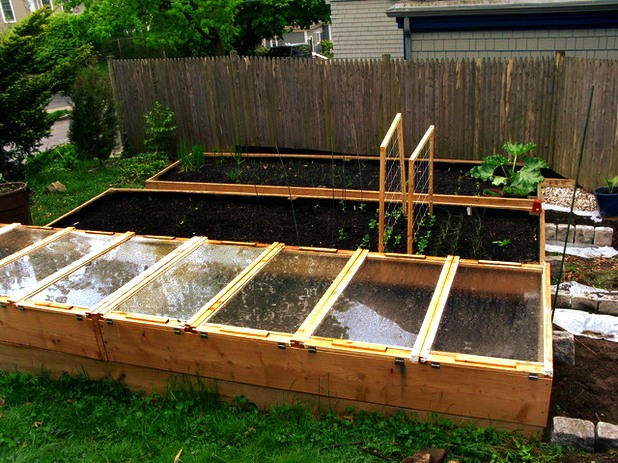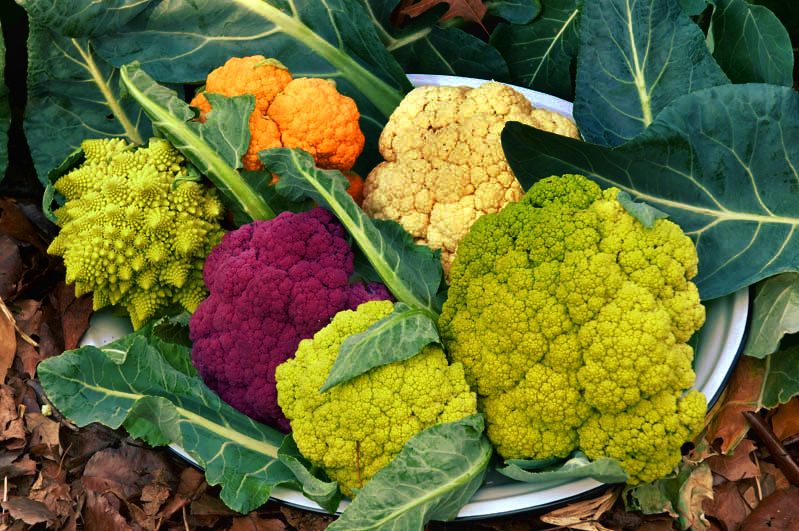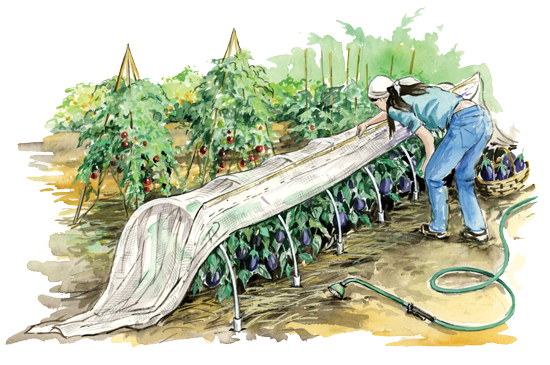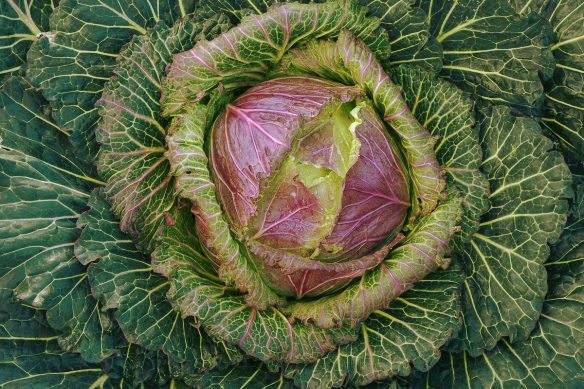“Cold Frame Plants”: Broccoli, Cabbage, & Cauliflower
Broccoli, Cabbage, & Cauliflower are all grown similarly. They’re all “cool weather plants”. Cauliflower can be planted the earliest– as early as January. The best way to grow these plants is using a Cold Frame (PHOTO SOURCE: http://www.houzz.com/ideabooks/3439193/list/how-to-start-a-cool-season-vegetable-garden):
January-June:
Cauliflower:
If you plant to attempt growing cauliflower in the home garden, it requires consistently cool temperatures with temperatures in the 60s. Otherwise, it prematurely “button”—form small button-size heads—rather than forming one, nice white head.
-
Select a site with at lesat 6 hours of full sun.
-
Soil needs be very rich in organic matter; add composted mature to the soil before planting. Fertile soil holds in moiture to prevent heads from “buttoning.”
-
Test your soil! (Get a soil test through your cooperative extension office.) The soil pH should be between 6.5 and 6.8.
-
It is best to start cauliflower from transplants rather than seeds. Transplant 2 to 4 weeks before the average frost date in the spring, no sooner and not much later.
-
Space the transplants 18 to 24 inches apart with 30 inches between rows. Use starter fertilizer when transplanting.
-
Plant fall cauliflower about the same time as fall cabbage. This is usually 6 to 8 weeks before the first fall frost and also need to be after the temperature is below 75 degrees F.
-
If you really want to try starting cauliflower from seeds, start the seeds 4 to 5 weeks before the plants are needed. Plant the seeds in rows 3 to 6 inches apart and ¼ to ½ of an inch deep. Do not forget to water the seeds during their germination and growth. Once they become seedlings, transplant them to their permanent place in the garden.
-
In early spring, be ready to cover your plants with old milk jugs or protection if needed. For fall crops, shade them if they need protection from the heat.
-
Add mulch to conserve moisture.
Care:
-
Make sure that the plants have uninterrupted growth. Any interruption can cause the plants to develop a head prematurely or ruin the edible part completely.
-
Cauliflower requires consistent soil moisture. They need 1 to 1.5 inches of water each week; with normal rainfall, this usually requires supplement watering.
-
For best growth, side-dress the plants with a nitrogen fertilizer.
-
Note that the cauliflower will start out as a loose head and it takes time for the head to form. Many varieties take at least 75 to 85 days from transplant. Be patient.
-
When the curd (the white head) is about 2 to 3 inches in diameter, tie the outer leaves together over the head with a rubber band, tape, or twine. This is called blanching, and it protects the head from the sun and helps you get that pretty white color.
-
The plants are usually ready for harvest 7 to 12 days after blanching.
Typical Pests:
-
Cabbageworm
-
Aphids
-
Harlequin bugs
-
Clubroot
-
Black rot
Harvest/Storage:
-
When the heads are compact, white, and firm, then it is time to harvest them. Ideally, the heads will grow 6 to 8 inches in diameter.
-
Cut the heads off the plant with a large knife. Be sure to leave some of the leaves around the head to keep it protected.
-
If the heads are too small but have started to open up, they will not improve and should be harvested.
-
If the cauliflower has a coarse appearance, it is too mature and should be tossed.
-
If you want to store cauliflower, you can put the head in a plastic bag and store it in the refrigerator. It should last for about a week.
-
For long-term storage, you can also freeze or pickle the heads.[9]
Plant Out: March-July Harvest: July-November
April-June:
Broccoli:
Choose a sunny site with fertile, well-drained, well-built soil. Loosen the planting bed & mix in up to 1 inch of mature compost. Water the bed thoroughly before setting out seedlings.
Leaf-eating caterpillars — including army worms, cabbageworms, & cabbage loopers — like to feast on broccoli leaves. In summer, harlequin bugs & grasshoppers can devastate young plants. Prevent these problems by growing plants beneath row covers, as shown:
Plant Out: June-July Harvest: July-August
February-June:
Cabbage:
Starting Cabbage Indoors:
Spring: Start seeds indoors or in a cold frame eight to 10 weeks before your last spring frost, and set out hardened-off seedlings when they are about 6 weeks old. Seeds germinate best at 65 to 75 degrees Fahrenheit.
Summer: Start seeds 12 to 14 weeks before your first fall frost, & transplant the seedlings to the garden when they are 4 to 6 weeks old. Plant early & late varieties to stretch your harvest season.
How to Plant:
Growing cabbage plants requires regular feeding & abundant sun. Choose a sunny, well-drained site with fertile soil. Loosen the planting bed & mix in a 2-inch layer of compost. Water the fertilized bed thoroughly before setting out seedlings. Allow 18 to 20 inches between plants for 4-pound varieties; larger varieties may need more room. Varieties that will produce heads that weigh less than 2 pounds (check your seed packet) can be spaced 12 inches apart.
Harvesting and Storage
Begin harvesting cabbage when the heads feel firm, using a sharp knife to cut the heads from the stem. Remove & compost rough outer leaves, & promptly refrigerate harvested heads. If cut high, many varieties will produce several smaller secondary heads from the roots & crown left behind.
Cabbage will store in the refrigerator for two weeks or more, & you can keep your fall crop in cool storage for several months. Clean cabbage carefully, because heads may harbor hidden insects.[5]
Plant Out: February-June Harvest: June-October
Cabbage Can Be Re-Grown From Leaves!
Cabbage is relatively easy to grow from scraps. Simply place your leftover leaves in a bowl with just a bit of water in the bottom. Keep the bowl somewhere that gets good sunlight & mist the leaves with water a couple of times each week. After 3 or 4 days, roots will begin to appear along with new leaves. When this happens you can transplant the cabbage in soil.[6]

How to grow Broccoli AND photo of Broccoli under Row Covers from Mother Earth News: http://www.motherearthnews.com/organic-gardening/growing-broccoli-zmaz09aszraw.aspx
Photo of Cabbage: https://lopezislandkitchengardens.wordpress.com/
[5]: How to Grow Cabbage by Mother Earth News: http://www.motherearthnews.com/organic-gardening/vegetables/growing-cabbage-zm0z12aszkon.aspx
Photo of Heirloom Cauliflower Varieties: http://masterofhort.com/2015/01/
[9]: “How To Grow Cauliflower” from The Old Farmer’s Almanac: http://www.almanac.com/plant/cauliflower
Notice Regarding all Campaign Contributions
Wild Willpower PAC is a nonpartisan “nonconnected PAC”, registered with the IRS as a 527 tax exempt political organization. Contributions will be used to directly and/or indirectly influence the selection, nomination, election, or appointment of individual(s) to federal, state, and local public offices, and to offices in political organizations. Wild Willpower only promotes candidates who align themselves with our National Plan. Due to FEC restrictions we may not accept contributions from foreign nationals.




